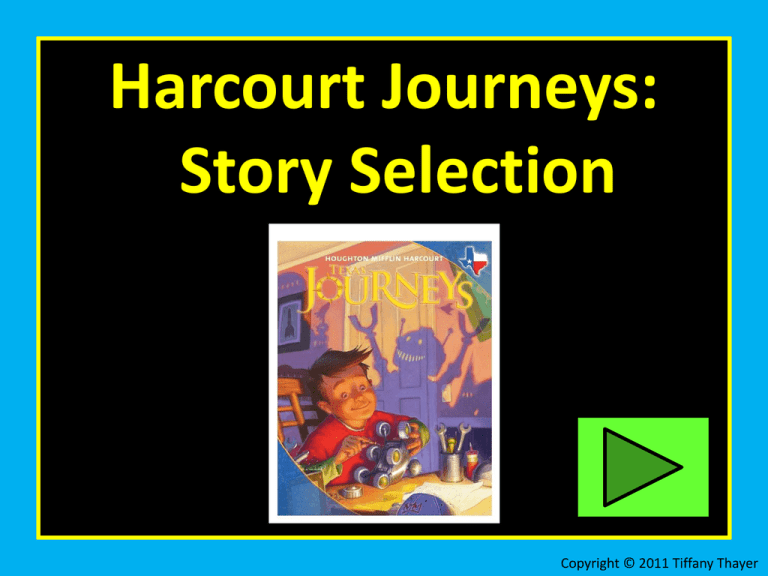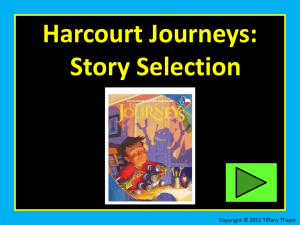Unit+3+Lesson+14+Story+Selection+The Life and Times of the Ant
advertisement

Harcourt Journeys: Story Selection Copyright © 2011 Tiffany Thayer Unit 3: Lesson 14 “The Life and Times of the Ant” Copyright © 2011 Tiffany Thayer Turn your Text Book to page 352. Copyright © 2011 Tiffany Thayer 1 2 Why do you think the author wrote about ants? Answer Copyright © 2011 Tiffany Thayer Answer: To inform readers about how important ants are and what they do for the earth. Copyright © 2011 Tiffany Thayer According to the timeline, which creature has lived on Earth the longest? Why do you think the author includes a timeline? Answer Copyright © 2011 Tiffany Thayer Answer: Ants have lived on Earth the longest. To help readers “see” how long ants have existed compared to dinosaurs and humans. Copyright © 2011 Tiffany Thayer 3 What makes ants social animals? Answer Copyright © 2011 Tiffany Thayer Answer: They live and work together and solves their problems. Copyright © 2011 Tiffany Thayer 4 5 6 What are the main reasons that ants construct their homes underground? Answer Copyright © 2011 Tiffany Thayer Answer: for shelter from the weather, to create a safe place for the queen to lay eggs, and to store food. Copyright © 2011 Tiffany Thayer How does the transfer of heat make and anthill warmer than the area around it? Answer Copyright © 2011 Tiffany Thayer Answer: As the sun beats on an anthill, it absorbs the heat and transfers it down to the nest. Copyright © 2011 Tiffany Thayer What are some positive effects of building a nest beneath a rock or log? Answer Copyright © 2011 Tiffany Thayer Answer: The nest is protected and stays warm. Copyright © 2011 Tiffany Thayer 7 8 How are the ants’ lives similar and different from peoples’ lives? Answer Copyright © 2011 Tiffany Thayer Answer: Different: Ants work their entire lives, people do not. Similar: Animals perform some of the same jobs people do, both work together to solve problems. Copyright © 2011 Tiffany Thayer What main ideas do the details provide in “A Life of Work” support? Answer Copyright © 2011 Tiffany Thayer Answer: The life of an ant colony is a very busy place; ants work throughout their lives to support the colony. Copyright © 2011 Tiffany Thayer 9 Why do you think younger ants tend the queen and dig tunnels? Answer Copyright © 2011 Tiffany Thayer Answer: These jobs help them bond and they are hard workers. Copyright © 2011 Tiffany Thayer 10 11 What do the ants “highways” tell you about the distances some ants have to travel to get food? Answer Copyright © 2011 Tiffany Thayer Answer: The distance to their food sources may be very great. Copyright © 2011 Tiffany Thayer How do harvester ants help wildflower plants grow in new places? Answer Copyright © 2011 Tiffany Thayer Answer: The ants collect wildflower seeds and bring them back to the anthill. The seeds they don’t eat grow into new plants near the anthill. Copyright © 2011 Tiffany Thayer 12 What information in the text does the chart help to explain? How? Answer Copyright © 2011 Tiffany Thayer Answer: The text says that Harlow Shapley tested ants’ speeds at different temperatures, and the chart details his findings. Copyright © 2011 Tiffany Thayer 13 How would you summarize the main idea of “A Dangerous World”? Answer Copyright © 2011 Tiffany Thayer Answer: The world can be a dangerous place for ants because they have so many predators. Copyright © 2011 Tiffany Thayer 14 What details explain how a giant anteater is specialized to eat ants? Answer Copyright © 2011 Tiffany Thayer Answer: Its tongue, mouth and snout help it finds and trap ants and termites; its claws help it dig into the nest; its tail helps it sweep up ants; and its hair and stomach help protect it and digest the ants. Copyright © 2011 Tiffany Thayer 15 16 How do leafcutter ants help Earth? Answer Copyright © 2011 Tiffany Thayer Answer: As fungus from leaves decomposes, it releases nutrients that helps new plants grow. Copyright © 2011 Tiffany Thayer How do the illustrations and captions show what leafcutter ants do? Answer Copyright © 2011 Tiffany Thayer Answer: They help explain what happens in each step on the ants’ work. Copyright © 2011 Tiffany Thayer Projectable 14.3 Copyright © 2011 Tiffany Thayer Projectable 14.4 Copyright © 2011 Tiffany Thayer How did you do?







